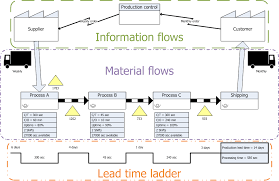Lean thinking is really conceptualizing lean principles and how they apply to a specific enterprise. Because Lean principles started in Japan with the Toyota Production System, its primary application has been in manufacturing. Today, Lean manufacturing has been growing in interest and popularity as more and more companies look for increased agility, faster to-market production, and stream-lined processes that reduce wasteful practices. Its implementation has even spread outside of fabrication into a broader business use.
Whether in lean manufacturing or lean management in other industries, five primary principles have been established to capture the goals of lean. These concepts were captured by, and summarized here based on the book “Lean Thinking” by Womack and Jones. And while the concepts themselves are simple, the implementation takes time as perfection is the final goal.
Lean Thinking Concept 1: Value
Value is what is delivered, and set primarily by the customer. What the consumer is willing to pay should be the goal of production to meet that value and also provide profit to the producing company. For example, if a consumer is willing to pay $10 for a widget, the company should use that value as their benchmark for production, eliminating waste and improving processes to meet customer expectations.
When customers are having their expectations met and companies are making profits, this is considered perfection.
Lean Thinking Concept 2: The Value Stream
Understanding the flow of the life-cycle of a product is the only way to truly eliminate waste. The Value Stream concept examines the flow from production to disposal of any given product to find areas where value is lacking and can be improved, or where processes are wasteful. Some wasteful processes may be unavoidable due to certain circumstances such as lack of technological advances or access to resources.
The awareness that is created in regards to the wasteful processes allow them to be corrected or improved for better outcomes.
Lean Thinking Concept 3: Flow
Flow refers to the state by which all processes are in alignment making production move forward without interruption. As wasteful practices are eliminated, production increases. This includes processes that previously halted product launches and to-market deliverables, something critical in today’s market where agility, speed and quality are of tremendous value.
Flow is the state where wasteful down-time no longer exists.
Lean Thinking Concept 4: Pull
Lean concepts tend to reduce cold inventory because rather than relying on forecasting demand, they put in place communication and manufacturing methods that allow for production on the fly – as customers order.
What if “busy work” was eliminated and production only happened when a sale closed? It’s a revolutionary mindset and manufacturing concept that both increases efficiency and output.
Lean Thinking Concept 5: Perfection
While we have all been taught that nothing is perfect, lean concepts are rooted in achieving perfection through continuous improvement. When an organization truly implements lean tools and concepts, they strive to get to the root of problems, never using a “band-aid” approach for fixes, but rather really dig into data and processes, and be willing to change based on feedback. They in essence create agility in business by being perfectionists focusing on lean.
Contact me today to learn more about lean thinking and how to apply it to your business to create more efficiency and profitability. Together, we will create a continuous improvement culture and healthier bottom line.

